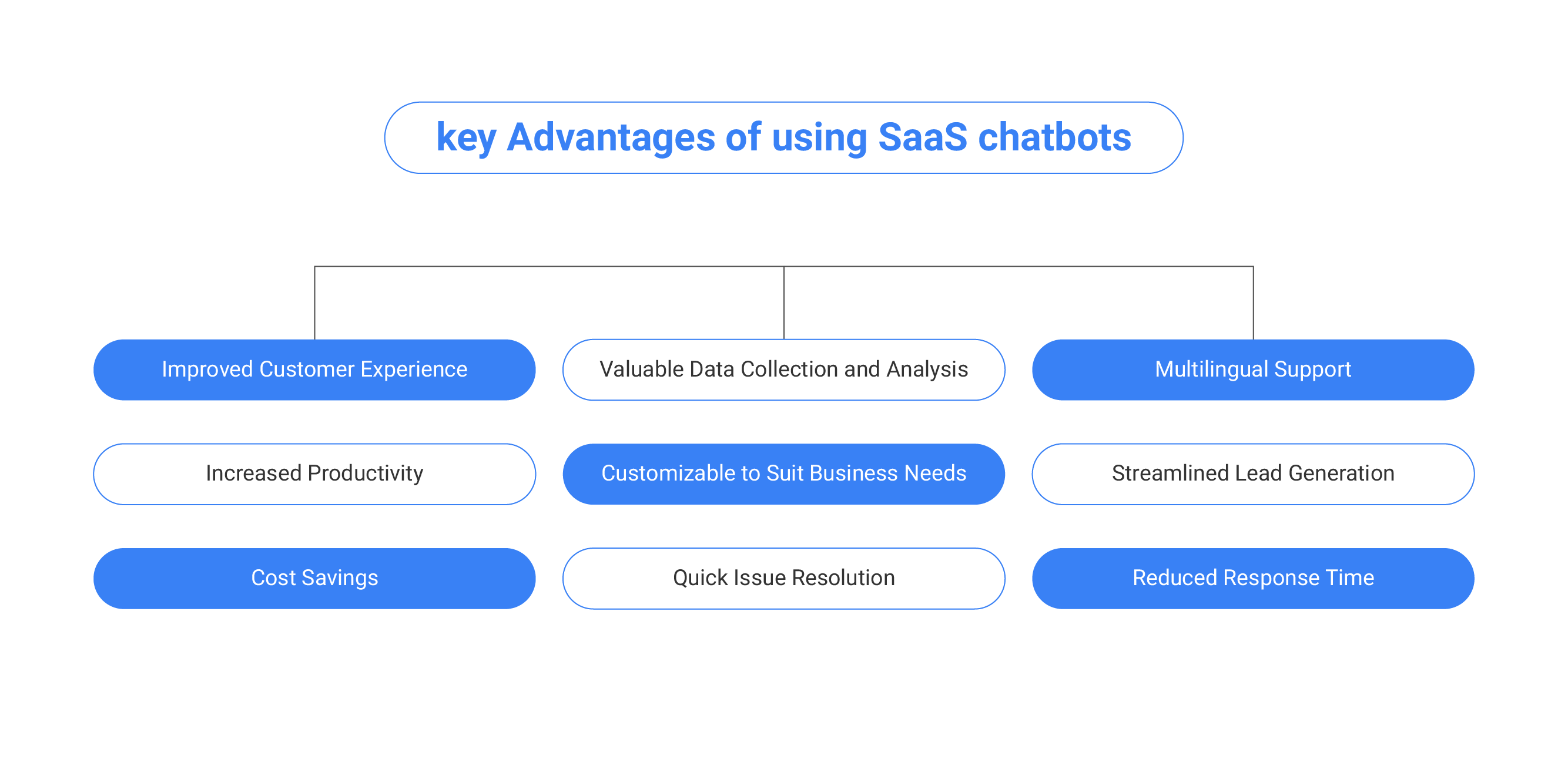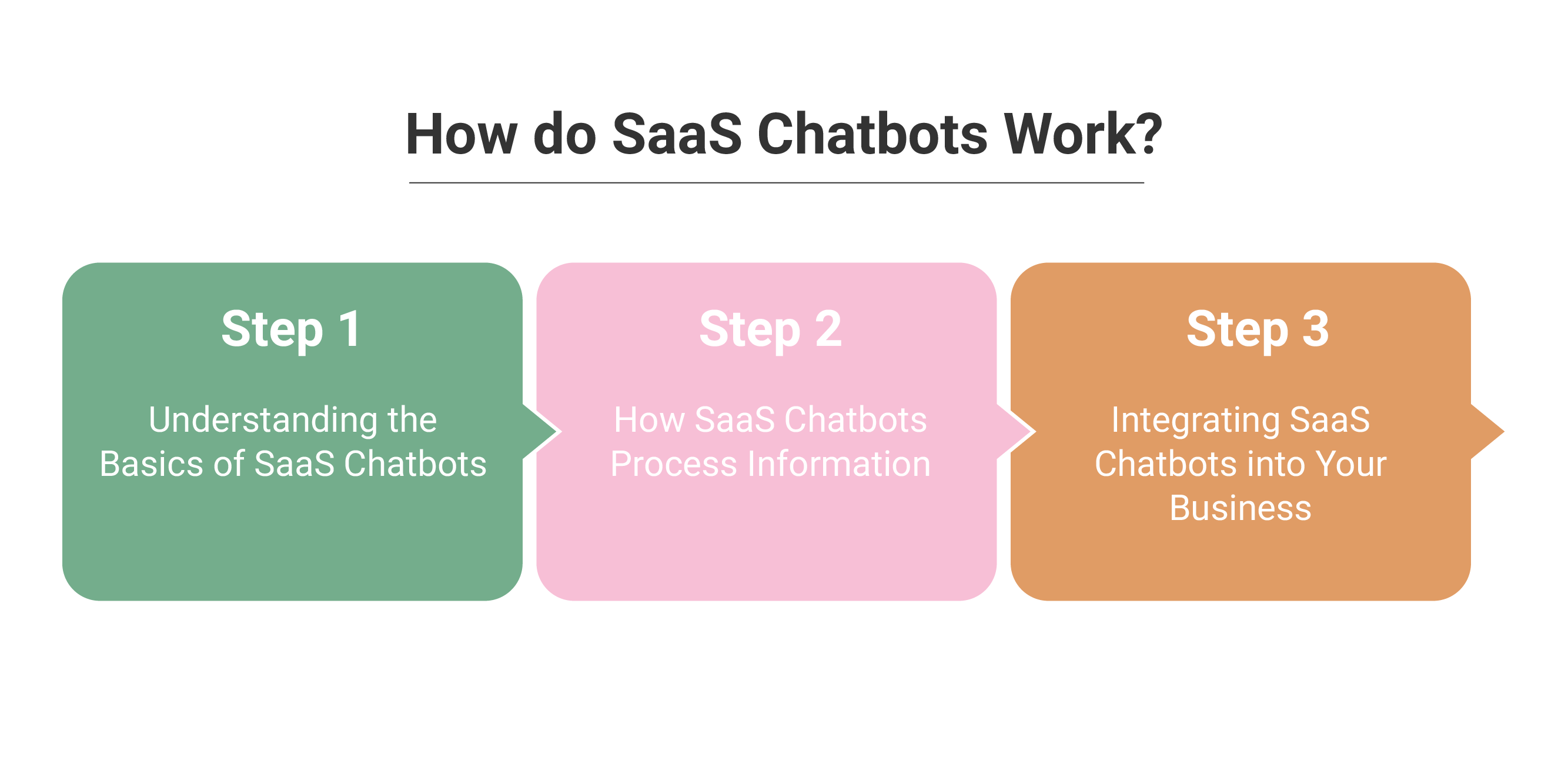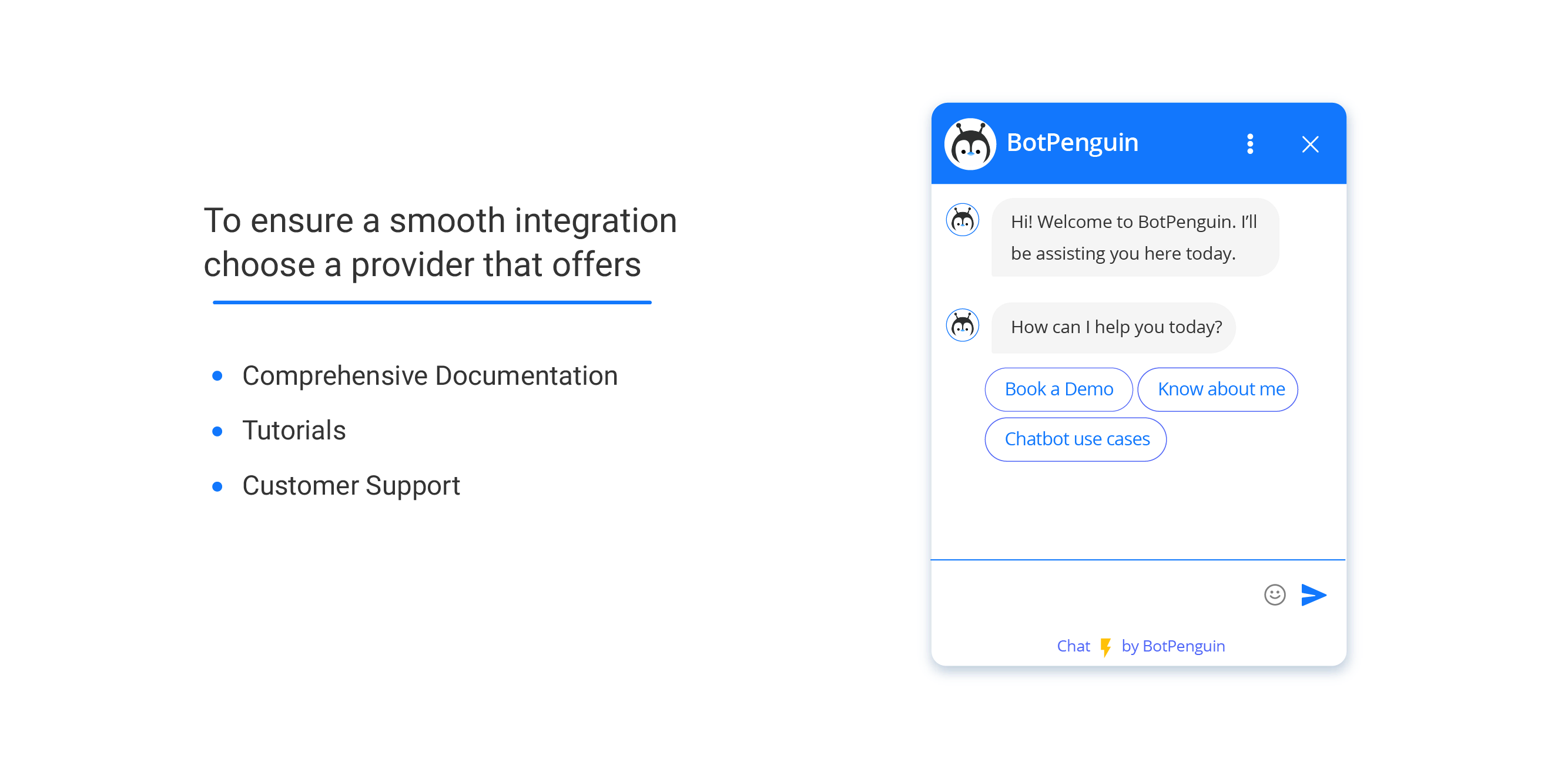The global chatbot will reach $10.08 billion by 2026, growing at a CAGR of 24.3% from 2019 to 2023.
The rapid growth of the chatbot market is a testament to the growing demand for AI-powered solutions that can transform how businesses interact with their customers.
Customers expect immediate and personalized support in today's digital age, and businesses are turning to SaaS chatbots to meet these demands.
SaaS chatbots provide a range of unmatched benefits at a competitive cost.
This guide will explore the technology behind SaaS chatbots, their benefits, and how businesses can integrate them into their operations.
Whether you're a seasoned entrepreneur or just starting your business, some valuable tidbits are here. Read on!
What are SaaS Chatbots?
SaaS chatbots are AI-powered virtual assistants that use NLP and
ML to interact with customers.
These chatbots are hosted by a third-party provider, making them available to businesses through the cloud.
It eliminates the need to invest in expensive hardware and software to run the chatbots in-house.
Why use SaaS Chatbots?

SaaS chatbots offer a range of benefits for businesses of all sizes and industries. This section will explore some of the key advantages of using SaaS chatbots.
Improved Customer Experience:
SaaS chatbots provide an accessible and convenient way for customers to interact with businesses. They can quickly answer customer queries and provide solutions, leading to higher customer satisfaction rates.
With a chatbot, businesses can offer 24/7 customer support, ensuring that customers are attended to even outside business hours.
Increased Productivity:
You can easily handle routine tasks, freeing human resources to focus on more complex and strategic tasks. It leads to increased productivity and efficiency, driving business growth.
Chatbots can simultaneously handle large requests, ensuring that customers are attended to promptly.
Cost Savings:
SaaS chatbots come as a service, meaning businesses do not need to invest in infrastructure, maintenance, and updates.
It helps in cost savings, particularly for small and medium-sized businesses. Additionally, chatbots can handle large requests, reducing the need for additional human resources.
Valuable Data Collection and Analysis:
Businesses can easily collect and analyze valuable data, providing businesses with insights into customer preferences and behavior.
This information can inform future marketing strategies, leading to more effective targeting and higher conversion rates.
With a multifunctional dashboard like in BotPenguin, you can track and scope out areas for improvement.
Customizable to Suit Business Needs:
You can tailor SaaS chatbots to suit the needs of individual businesses. Businesses can add their branding, voice, and tone to the chatbot, ensuring a personalized customer experience.
It can improve brand loyalty and customer retention rates.
Quick Issue Resolution:
SaaS chatbots can quickly resolve customer issues, leading to a higher issue resolution rate and lower customer churn rates.
Customers can also escalate requests to human agents if necessary, ensuring that the customer experience is not compromised.
Multilingual Support:
SaaS chatbots can support multiple languages, making it easy for businesses to cater to a global audience.
With a multilingual chatbot, businesses can provide customer support in different languages, improving the customer experience and expanding their reach.
Streamlined Lead Generation:
SaaS chatbots can engage with potential customers, collect their information, and forward it to sales teams for follow-up.
It generates new leads and closes more deals, improving revenue and growth.
Chatbots can also qualify leads based on predefined criteria, ensuring that sales teams prioritize high-quality leads.
Reduced Response Time:
SaaS chatbots can respond to customer queries and requests in real time, reducing response time and improving the customer experience.
With a chatbot in place, customers can resolve their issues quickly, leading to higher customer satisfaction rates.
Improved Brand Reputation:
Brands can improve brand reputation by providing a consistent and high-quality customer experience.
You can ensure customer queries and requests are handled promptly and professionally, which can lead to positive customer feedback and referrals.
Seamless Integration with Other Tools:
You can seamlessly integrate with other tools, CRMs, automation tools like Zapier, etc.
It will give you a comprehensive view of customer behavior and preferences, allowing for more effective targeting and higher conversion rates.
Chatbot Platforms like BotPenguin offer 60+ native integrations. Sweet, isn't it?
How do SaaS Chatbots Work?

Step 1: Understanding the Basics of SaaS Chatbots
SaaS chatbots are computer programs that can interact with users via text or voice.
They're designed to simulate human conversation, allowing businesses to automate repetitive or time-consuming tasks.
You can integrate bots into various platforms, including websites, mobile apps, and messaging platforms like Facebook Messenger.
Step 2: How SaaS Chatbots Process Information
SaaS chatbots work by processing information in two ways: through rule-based systems or artificial intelligence.
Rule-based systems are designed to respond to specific questions and commands based on pre-determined rules set by the chatbot's creators.
Artificial intelligence-powered chatbots, on the other hand, use machine learning algorithms to understand and respond to user requests more naturally.
Step 3: Integrating SaaS Chatbots into Your Business
Integrating a SaaS chatbot into your business is straightforward.
Simply choose a platform compatible with your existing systems, configure the chatbot to your specific needs, and begin using it to automate repetitive tasks and improve customer interactions.
How to integrate a SaaS Chatbot into your business?
Integrating a SaaS chatbot into your business can seem challenging, but with the right approach, it can be a smooth and straightforward process.
Step 1: Determine Your Goals and Requirements
The first step in integrating a SaaS chatbot into your business is determining your goals and requirements. Identify the areas of your business where a chatbot can provide the most value, such as customer support, lead generation, or HR management. Consider your budget, time constraints, and the features and functionality required in a chatbot.
Step 2: Choose a SaaS Chatbot Provider

Choose a SaaS chatbot provider that meets your specific needs and requirements.
Consider features, functionality, ease of use, integration with existing tools, and customer support.
Choose a provider that offers comprehensive documentation, tutorials, and customer support to ensure a smooth integration process. For example:- BotPenguin
Step 3: Customize Your Chatbot
Customize your chatbot to suit the specific needs of your business. Consider the tone and personality of your brand, and ensure that your chatbot's responses are consistent with your brand image. Customize the chatbot's features and functionality, such as language support, integrations with other tools, and data collection and analysis capabilities.
Step 4: Integrate the Chatbot with Your Existing Tools
Integrate the chatbot with your existing tools and systems, such as your website, social media pages, and messaging platforms. Ensure that the chatbot is accessible and visible to your customers and that it can handle a range of queries and requests.
Step 5: Test and Monitor Your Chatbot
Test your chatbot to ensure that it functions as intended and provides value to your business. Monitor the chatbot's performance, collecting and analyzing data to inform future marketing strategies and customer service initiatives.
Step 6: Train Your Team
Train your team on how to use and manage the chatbot effectively. Ensure that they are equipped with the necessary skills and resources to handle more complex queries and provide customer support.
SaaS Chatbots Use Cases

Customer Support:
You can provide 24/7 customer support, handling routine queries and issues. It will free human resources to focus on more complex and strategic tasks, increasing productivity and efficiency. Chatbots can also simultaneously handle a large volume of requests, ensuring that customers are attended to promptly.
Lead Generation:
SaaS chatbots can engage with potential customers, collect their information, and forward it to sales teams for follow-up. Hence, you can focus on generating new leads and close more deals, improving revenue and growth.
Chatbots can also qualify leads based on predefined criteria, ensuring that sales teams prioritize high-quality leads.
E-commerce:
SaaS chatbots can facilitate e-commerce transactions, allowing customers to place orders and make payments through the chatbot. It can streamline the purchasing process and improve the customer experience.
HR Management:
SaaS chatbots can easily handle routine HR tasks such as scheduling, onboarding, and training. It will free HR staff to focus on more strategic tasks, improving productivity and efficiency.
Appointment Scheduling:
You can automate handle appointment scheduling, allowing customers to book appointments and receive reminders directly through the chatbot. It can reduce no-shows and improve customer satisfaction.
Marketing and Sales:
SaaS chatbots can assist with marketing and sales tasks such as lead nurturing, personalized recommendations, and cart abandonment recovery. It will help you improve your marketing and sales strategies, leading to higher conversion rates and revenue.
Choosing a SaaS Chatbot Provider:
Choosing the right SaaS chatbot provider is critical to the success of your chatbot implementation.
Here are the different factors you should consider when selecting a SaaS chatbot provider and the questions you should ask before making a decision.
Features and Functionality:
When choosing a SaaS chatbot provider, the first factor you should consider is the features and functionality of the chatbot.
Look for a chatbot that can handle the specific requirements of your business, such as language support, customization, and integration with other tools.
It's also important to consider the chatbot's ability to handle complex queries and escalate to human agents if necessary.
Integration with Existing Tools:
The chatbot should integrate seamlessly with your existing tools, such as your website, social media pages, and messaging platforms. It will ensure a consistent customer experience and streamline business operations.
Chatbot platforms Like BotPenguin offer a ton of native integrations. With Zapier you can combine up to 600+ apps.
Ease of Use and Setup:
Choose a chatbot that is easy to use and set up. A chatbot with a simple interface and intuitive design can save you time and effort, allowing you to focus on other aspects of your business.
Data Collection and Analysis:
Choose a chatbot that can collect and analyze valuable data, providing insights into customer preferences and behavior. This will inform your future marketing strategies, leading to more effective targeting and higher conversion rates.
Customer Support and Training:
Choose a provider that offers comprehensive customer support and training. Look for a provider that offers 24/7 technical support and resources such as tutorials and documentation. Ensure that your chatbot implementation runs smoothly and that your team is equipped with the necessary skills to use the chatbot effectively.
Cost and Scalability:
Choose a provider that offers a pricing model that suits your budget and business needs. Consider the costs associated with implementation, maintenance, and updates, and ensure that the chatbot is scalable to accommodate future growth.
Reputation and Reviews:
Look for a provider with a good reputation and positive reviews. Check online forums and review sites to see what other customers say about the provider and their chatbot. It will give you an idea of the provider's reliability, quality of service, and customer satisfaction rates.
Questions to Ask Before Choosing a SaaS Chatbot Provider:
- What specific features and functionality does the chatbot offer?
- How does the chatbot integrate with my existing tools and systems?
- What technical expertise is required to set up and use the chatbot?
- What kind of data collection and analysis capabilities does the chatbot have?
- What kind of customer support and training does the provider offer?
- What are the costs associated with implementing, maintaining, and updating the chatbot?
- Can the chatbot accommodate future growth, and what is the provider's scalability plan?
- What is the provider's reputation in the market, and what do their customers say about them?
Conclusion
SaaS chatbots are a powerful tool for businesses looking to improve customer experience, increase productivity, and reduce costs. From automation to streamlining business operations, these bots can make a significant impact.
At BotPenguin, we offer a state-of-the-art SaaS chatbot solution that can transform how you interact with your customers.
With the global chatbot market growing exponentially, there's no better time to invest in a SaaS chatbot solution.
By leveraging the power of chatbots, you provide personalized and effective support that leads to higher customer satisfaction and business growth.
FAQs
What is a SaaS chatbot?
A SaaS chatbot is a cloud-based software program that interacts with customers using natural language. It feels like a conversation. It offers businesses an accessible and cost-effective way to provide 24/7 customer service support.
What are the four types of chatbots?
The four types of chatbots are rule-based, AI, virtual assistants, and social messaging. Each type is designed to provide different functionalities based on the business's specific needs.
What are some examples of chatbots?
Chatbots like Siri, Alexa, and Google Assistant are popular examples of chatbots used daily. Other examples of chatbots include customer service like Bank of America's Erica and chatbots used for lead generation like Intercom.
How do SaaS chatbots differ from traditional chatbots?
SaaS chatbots are cloud-based and provided as a service, whereas traditional chatbots are built in-house and require infrastructure, maintenance, and updates. This makes SaaS chatbots more accessible to all businesses.
What are the benefits of using a SaaS chatbot?
SaaS chatbots can improve customer experience, increase productivity, save costs, and provide valuable data analysis. They can also handle routine tasks and allow businesses to focus on more complex tasks, improving efficiency.
How do SaaS chatbots work?
SaaS chatbots use natural language processing and machine learning algorithms to understand and respond to queries and requests. They can escalate requests to human agents if necessary so the customer experience is not compromised.
Can SaaS chatbots be customized?
Yes, businesses can customize SaaS chatbots according to their specific needs. Businesses can add their branding, voice, and tone to the chatbot, ensuring a personalized customer experience.
How can businesses integrate SaaS chatbots into their operations?
Businesses can incorporate SaaS chatbots by embedding them on their websites, social media pages, and messaging platforms. This allows businesses to provide 24/7 customer support, freeing human resources to focus on more complex tasks.
How do SaaS chatbots benefit customer service?
SaaS chatbots help customer service by providing 24/7 availability, handling large requests simultaneously, and quickly resolving issues. This results in higher customer satisfaction and improved brand reputation.
How can SaaS chatbots improve productivity?
SaaS chatbots can improve productivity by handling routine and repetitive tasks, freeing up human resources to focus on more complex and strategic tasks. It enhances efficiency and drives business growth.
What types of businesses can benefit from using SaaS chatbots?
Businesses of all sizes from various industries can benefit from SaaS chatbots, particularly those with high customer queries and requests. These businesses can streamline operations, reduce costs, and improve customer satisfaction.
What security features do SaaS chatbot providers offer?
SaaS chatbot providers offer a range of security features such as encryption, access control, and data privacy to protect sensitive information. It provides businesses with peace of mind and keeps customer data safe.
What kind of customer support do SaaS chatbot providers offer?
SaaS chatbot providers offer customer support to help businesses troubleshoot any issues that may arise with the chatbot. They can provide technical assistance, ensuring the chatbot runs smoothly.
Can SaaS chatbots be used for lead generation?
Yes, you can use SaaS chatbots for lead generation by engaging with potential customers, collecting their information, and forwarding it to sales teams for follow-up.
It can help businesses generate new leads and close more deals, improving revenue and growth. SaaS chatbots can also help businesses understand customer preferences and behavior, which can inform future marketing strategies.


